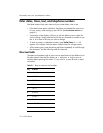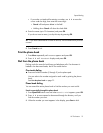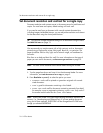
HP Fax basics 23
Document types and sizes
•
Chemically treated paper (pressure-sensitive paper, carbon-coated paper,
etc.)
• Coated (glossy, photo, etc.)
• Papers with raised, embossed lettering
Document types and sizes
The following document size is acceptable when you send a fax.
• The minimum document size is 148 mm (5.8 in.) wide by 128 mm (5 in.)
long.
• The maximum size is 216 mm (8.5 in.) wide by 356 mm (14 in.) long.
Follow these tips to ensure worry-free faxing.
• Be sure that your document is dry and free of staples, paper clips, and other
foreign objects.
• If you are sending more than one sheet, make sure the bottom sheet enters
first. Insert the sheets with a slight push to ensure smooth feeding.
• For multiple sheets, all pages of the document must be the same size and
paper type.
• If you are loading pages that are unusually thick or thin, feed one sheet at a
time. If the document does not feed correctly, open the control panel, remove
the document, and try loading it again.
• For more information on what kind of paper you can use for documents,
see
Acceptable documents on page 63.
DO NOT try to send documents that are:
• wet
• covered with wet ink or paste
• wrinkled, curled, or folded
• too thin (less than 0.07 mm (0.18 in.) thick—onionskin, airmail paper, etc.)
• too thick (more than 0.15 mm (0.38 in.) thick—index cards, file folders)
• chemically processed (pressure-sensitive paper, carbon-coated paper, etc.)
• coated (glossy, etc.)
• too small or short (such as a label, voucher, etc.)
• made of cloth or metal
To send these documents, use an office copier to make a photocopy first, and
then send the copy.


















